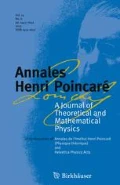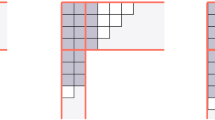Abstract
We present a new conjectural symmetry of the colored Alexander polynomial, that is the specialization of the quantum \(\mathfrak {sl}_N\) invariant widely known as the colored HOMFLY-PT polynomial. We provide arguments in support of the existence of the symmetry by studying the loop expansion and the character expansion of the colored HOMFLY-PT polynomial. We study the constraints this symmetry imposes on the group theoretic structure of the loop expansion and provide solutions to those constraints. The symmetry is a powerful tool for research on polynomial knot invariants and in the end we suggest several possible applications of the symmetry.
Similar content being viewed by others
References
Witten, E.: Quantum field theory and the Jones polynomial. Commun. Math. Phys. 121, 351 (1989)
Chern, S.-S., Simons, J.: Characteristic forms and geometric invariants. Ann. Math. 99, 48–69 (1974)
Kaul, R.K., Govindarajan, T.R.: Three dimensional Chern–Simons theory as a theory of knots and links. Nucl. Phys. B 380, 293–336 (1992). arXiv:hep-th/9111063
Kaul, R.K., Govindarajan, T.R.: Three-dimensional Chern–Simons theory as a theory of knots and links:(II). Multicoloured links. Nucl. Phys. B 393, 392–412 (1993)
Ramadevi, P., Govindarajan, T.R., Kaul, R.K.: Three-dimensional Chern–Simons theory as a theory of knots and links (III). Compact semi-simple group. Nucl. Phys. B 402, 548–566 (1993). arXiv:hep-th/9212110
Ramadevi, P., Govindarajan, T.R., Kaul, R.K.: Knot invariants from rational conformal field theories. Nucl. Phys. B 422, 291–306 (1994). arXiv:hep-th/9312215
Ramadevi, P., Govindarajan, T.R., Kaul, R.K.: Representations of composite braids and invariants for mutant knots and links in Chern–Simons field theories. Mod. Phys. Lett. A 10, 1635–1658 (1995). arXiv:hep-th/9412084
Turaev, V.G., Viro, O.Y.: State sum invariants of 3-manifolds and quantum 6j-symbols. Topology 31, 865 (1992)
Mironov, A., Morozov, A., Morozov, An: Character expansion for HOMFLY polynomials. II. Fundamental representation. Up to five strands in braid. JHEP 03, 034 (2012). arXiv:1112.2654
Anokhina, A., Mironov, A., Morozov, A., Morozov, An: Racah coefficients and extended HOMFLY polynomials for all 5-, 6- and 7-strand braids. Nucl. Phys. B 868, 271–313 (2013). arXiv:1207.0279
Anokhina, A., Morozov, An: Cabling procedure for the colored HOMFLY polynomials. Theor. Math. Phys. 178, 1–58 (2014). arXiv:1307.2216
Guadagnini, E., Martellini, M., Mintchev, M.: Chern–Simons field theory and quantum groups. In: Doebner, H.D., Hennig, J.D. (eds.) Quantum Groups. Lecture Notes in Physics, vol. 370. Springer, Berlin (1990)
Guadagnini, E., Martellini, M., Mintchev, M.: Chern–Simons holonomies and the appearance of quantum groups. Phys. Lett. B 235, 275 (1990)
Zodinmawia, P.R.: SU(N) quantum Racah coefficients and non-torus links (2011). arXiv:1107.3918
Zodinmawia, P.R.: Reformulated invariants for non-torus knots and links (2012). arXiv:1209.1346
Ooguri, H., Vafa, C.: Knot invariants and topological strings. Nucl. Phys. B 577, 419–438 (2000). arXiv:hep-th/9912123
Labastida, J.M.F., Mariño, M.: Polynomial invariants for torus knots and topological strings. Commun. Math. Phys. 217, 423–449 (2001). arXiv:hep-th/0004196
Labastida, J.M.F., Mariño, M., Vafa, C.: Knots, links and branes at large N. JHEP 0011, 007 (2000). arXiv:hep-th/0010102
Labastida, J.M.F., Mariño, M.: A new point of view in the theory of knot and link invariants (2001). arXiv:math/0104180
Mariño, M., Vafa, C.: Framed knots at large N (2001). arXiv:hep-th/0108064
Rosso, M., Jones, V.F.R.: On the invariants of torus knots derived from quantum groups. J. Knot Theory Ramif. 2, 97–112 (1993)
Viro, Oleg: Quantum relatives of Alexander polynomial. St. Petersbg. Math. J. 18, 05 (2002)
Rozansky, L., Saleur, H.: Reidemeister torsion, the Alexander polynomial and U(1, 1) Chern–Simons theory. J. Geom. Phys. 13, 105–123 (1994). arXiv:hep-th/9209073
Reshetikhin, N., Stroppel, C., Webster, B.: Schur–Weyl–Type Duality for Quantized gl(1|1), the Burau Representation of Braid Groups, and Invariants of Tangled Graphs, pp. 389–401. Birkhauser Boston, Boston (2013)
Kauffman, L.H., Saleur, H.: Free fermions and the Alexander–Conway polynomial. Commun. Math. Phys. 141, 293–327 (1991)
Mishnyakov, V., Sleptsov, A., Tselousov, N.: A novel symmetry of colored HOMFLY polynomials coming from sl(N/M) superalgebras (2020). arXiv:2005.01188
Itoyama, H., Mironov, A., Morozov, A., Morozov, An: Eigenvalue hypothesis for Racah matrices and HOMFLY polynomials for 3-strand knots in any symmetric and antisymmetric representations. Int. J. Mod. Phys. A 28, 1340009 (2013). arXiv:1209.6304
Dhara, S., Mironov, A., Morozov, A., Morozov, An., Ramadevi, P., Singh, V.K., Sleptsov, A.: Multi-colored links from 3-strand braids carrying arbitrary symmetric representations. Ann. Henri Poincaré 20(12), 4033–4054 (2019)
Bar-Natan, D.: Perturbative Chern–Simons theory. J. Knot Theor. Ramif. 4, 503–547 (1995)
Sleptsov, A.: Hidden structures of knot invariants. Int. J. Mod. Phys. A 29, 1430063 (2014)
Labastida, J.M.F., Perez, E.: Kontsevich integral for Vassiliev invariants from Chern–Simons perturbation theory in the light-cone gauge. J. Math. Phys. 39, 5183–5198 (1998). arXiv:hep-th/9710176
Dunin-Barkowski, P., Sleptsov, A., Smirnov, A.: Kontsevich integral for knots and Vassiliev invariants. Int. J. Mod. Phys. A 28, 1330025 (2013). arXiv:1112.5406
Chmutov, S., Duzhin, S.: The Kontsevich integral. In: Francoise, J.-P., Naber, G.L., Tsou, S.T. (eds.) Encyclopedia of Mathematical Physics, vol. 3, pp. 231–239. Elsevier, Oxford (2006). arXiv:math/0501040
Chmutov, S., Duzhin, S., Mostovoy, J.: Introduction to Vassiliev knot invariants (2011). arXiv:1103.5628
Reshetikhin, NYu., Turaev, V.G.: Ribbon graphs and their invariants derived from quantum groups. Commun. Math. Phys. 127, 1–26 (1990)
Liu, K., Peng, P.: Proof of the Labastida–Marino–Ooguri–Vafa conjecture. J. Differ. Geom. 85(3), 479–525 (2010). arXiv:0704.1526
Kirillov, A., Reshetikhin, N.: Representations of the Algebra \(U_q(sl_2)\), q-Orthogonal Polynomials and Invariants of Links. New Developments in the Theory of Knots, pp. 202–256. World Scientific, Singapore (1990)
Lin, X.-S., Zheng, H.: On the Hecke algebras and the colored HOMFLY polynomial. Trans. Am. Math. Soc. 362, 1–18 (2010). arXiv:math/0601267
Cromwell, P.R.: Knots and Links. Cambridge University Press, Cambridge (2004)
Itoyama, H., Mironov, A., Morozov, A., Morozov, An: HOMFLY and superpolynomials for figure eight knot in all symmetric and antisymmetric representations. J. High Energy Phys. 2012, 131 (2012). arXiv:1203.5978
Zhu, S.: Colored HOMFLY polynomial via skein theory. J. High Energy Phys. 2013, 229 (2013). arXiv:1206.5886
Mironov, A., Morozov, A.: Eigenvalue conjecture and colored Alexander polynomials. Eur. Phys. J. C 78, 284 (2018). arXiv:1610.03043
Miwa, T., Masaki Jinbo, M., Jimbo, E.Date: Differential Equations, Symmetries and Infinite Dimensional Algebras. Cambridge University Press, Cambridge (2000)
Mironov, A., Mironov, S., Mishnyakov, V., Morozov, A., Sleptsov, A.: Colored Alexander polynomials and KP hierarchy. Phys. Lett. B 783, 268–273 (2018). arXiv:1805.02761
Mishnyakov, V., Sleptsov, A.: Perturbative analysis of the colored Alexander polynomial and KP soliton \(\tau \)-functions (2019). arXiv:1906.05813
Stanley, R.: Enumerative Combinatorics, v.2. Cambridge University Press, Cambridge (1999). (p.461)
Mironov, A., Morozov, A., Natanzon, S.: Algebra of differential operators associated with Young diagrams. Theor. Math. Phys. 166, 1–22 (2011). arXiv:0904.4227
Mironov, A., Morozov, A., Natanzon, S.: Algebra of differential operators associated with Young diagrams. J. Geom. Phys. 62, 148–155 (2012). arXiv:1012.0433
Kharchev, S., Marshakov, A., Mironov, A., Morozov, A.: Generalized Kazakov–Migdal–Kontsevich model: group theory aspects. Int. J. Mod. Phys. A 10, 2015 (1995). arXiv:hep-th/9312210
Orlov, AYu., Scherbin, D.M.: Multivariate hypergeometric functions as tau functions of Toda lattice and Kadomtsev–Petviashvili equation. Physica D 152–153, 51–65 (2001). arXiv:math-ph/0003011
Okounkov, A., Pandharipande, R.: Gromov–Witten theory, Hurwitz theory, and completed cycles. Ann. Math. 163, 517 (2006). arXiv:math.AG/0204305
Alvarez, M., Labastida, J.M.F.: Numerical knot invariants of finite type from Chern–Simons perturbation theory. Nucl. Phys. B 433(3), 555–596 (1995)
Naculich, S.G., Schnitzer, H.J.: Duality between SU(N)-k and SU(k)-N WZW models. Nucl. Phys. B 347, 687 (1990)
Naculich, S.G., Riggs, H.A., Schnitzer, H.J.: Group level duality in WZW models and Chern–Simons theory. Phys. Lett. B 246, 417 (1990)
Mlawer, E.J., Naculich, S.G., Riggs, H.A., Schnitzer, H.J.: Group level duality of WZW fusion coefficients and Chern–Simons link observables. Nucl. Phys. B 352, 863 (1991)
Morozov, An, Sleptsov, A.: New symmetries for the \(U_q(sl_N)\) 6-j symbols from the Eigenvalue conjecture. JETP Lett. 108(10), 697–704 (2018)
Alekseev, V., Morozov, An., Sleptsov, A.: Interplay between symmetries of quantum 6-j symbols and the eigenvalue hypothesis. arXiv preprint arXiv:1909.07601 (2019)
Alekseev, V., Morozov, A., Sleptsov, A.: Multiplicity-free \(U_q(sl_N)\) 6-j symbols: relations, asymptotics, symmetries. Nucl. Phys. B 960, 115164 (2020)
Bishler, L., Morozov, A.: Perspectives of differential expansion (2020). arXiv:2006.01190
Garoufalidis, S., Lauda, A.D., Lê, T.T.Q.: The colored HOMFLYPT function is q-holonomic. Duke Math. J. 167, 397–447 (2018)
Kucharski, Piotr, Reineke, Markus, Stosic, Marko, Sułkowski, Piotr: Knots-quivers correspondence. Adv. Theor. Math. Phys. 23(7), 1849–1902 (2019)
Morton, H.R., Ryder, H.J.: Mutants and \(SU(3)_q\) invariants. Geom. Topol. Monogr. 1, 365–381 (1998). arXiv:math/9810197
Morton, H.R., Cromwell, P.R.: Distinguishing mutants by knot polynomials. J. Knot Theor. Ramif. 5, 225–238 (1996)
Bishler, L., Dhara, S., Grigoryev, T., Mironov, A., Morozov, A., Morozov, A., Ramadevi, P., Singh, V.K., Sleptsov, A.: Distinguishing mutant knots. J. Geom. Phys. 159, 103928 (2020)
Ozsváth, P., Szabó, Z.: On knot Floer homology and lens space surgeries. Topology 44(6), 1281–1300 (2005)
Anokhina, A., Morozov, A.: Towards R-matrix construction of Khovanov–Rozansky polynomials I. Primary T-deformation of HOMFLY. J. High Energy Phys. 2014(7), 63 (2014)
Anokhina, A., Morozov, A., Popolitov, A.: Nimble evolution for pretzel Khovanov polynomials. Eur. Phys. J. C 79(10), 867 (2019)
Brini, A., Mariño, M., Eynard, B.: Torus knots and mirror symmetry. Ann. Henri Poincaré 13, 1873–1910 (2012). https://doi.org/10.1007/s00023-012-0171-2
Dunin-Barkowski, P., Kazarian, M., Popolitov, A., Shadrin, S., Sleptsov, A.: Topological Recursion for the extended Ooguri-Vafa partition function of colored HOMFLY-PT polynomials of torus knots. arXiv:2010.11021 (2020)
Lodin, R., Popolitov, A., Shakirov, S., Zabzine, M.: Solving q-Virasoro constraints. Lett. Math. Phys. 110(1), 179–210 (2020)
Kolganov, N., Morozov, An: Quantum R-matrices as universal qubit gates. JETP Lett. 111, 519–524 (2020)
Melnikov, D., Mironov, A., Mironov, S., Morozov, A., Morozov, An: From topological to quantum entanglement. J. High Energy Phys. 2019(5), 116 (2019)
Mironov, S.: Topological entanglement and knots. Universe 5(2), 60 (2019)
Acknowledgements
This work was funded by the Russian Science Foundation (Grant No. 16-12-10344).
Author information
Authors and Affiliations
Corresponding author
Additional information
Communicated by Boris Pioline.
Publisher's Note
Springer Nature remains neutral with regard to jurisdictional claims in published maps and institutional affiliations.
The Quantum Dimensions
The Quantum Dimensions
Here we show that the quantum dimensions can only change the sign under the action of the tug-the-hook symmetry.
Let us consider a Young diagram R as the union of 5 parts.
-
1.
The white part of the size \(h \times h\), where h is the number of hooks
-
2.
The green part of the size \(g \times h\)
-
3.
The yellow part of the size \(y \times h\)
-
4.
The red part that consists of \(h-1\) rows of length \(r_1, r_2, \dots , r_{h - 1}\)
-
5.
The pink part that consists of \(h - 1\) columns of length \(p_1, p_2, \dots , p_{h - 1}\)

The formula for the quantum dimension of irreducible representation R
We consider the case \(N = 0\). Let us note that:
-
1.
The white part of the product in (94) remains the same under the action of the symmetry.
-
2.
The hook part (denominators) corresponding to the red and pink parts remains the same under the action of the symmetry.
Consider the green and yellow parts entirely and the numerators in the red and pink parts. To do this consider the ith row in the red part and the corresponding row in the green part. The contribution reads:
We see that the contribution does not depend on the green and yellow parts, namely g, b does not appear in the contribution. It means that this part is invariant under the tug-the-hook symmetry.
Next, consider the ith column in the pink part and the corresponding column in the yellow part. The contribution reads:
The contribution has y dependent part \((-1)^y\). the factor \((-1)^y\) comes from each yellow column and we get the resulting factor \((-1)^{y h}\). Under the action of the tug-the-hook symmetry only y, g parameters can change, namely \(y \rightarrow y - \epsilon \) and \(g \rightarrow g + \epsilon \). Considering the ratio we get
because all contributions except the factors \((-1)^{y}\) remain the same and cancel.
Rights and permissions
About this article
Cite this article
Mishnyakov, V., Sleptsov, A. & Tselousov, N. A New Symmetry of the Colored Alexander Polynomial. Ann. Henri Poincaré 22, 1235–1265 (2021). https://doi.org/10.1007/s00023-020-00980-8
Received:
Accepted:
Published:
Issue Date:
DOI: https://doi.org/10.1007/s00023-020-00980-8




